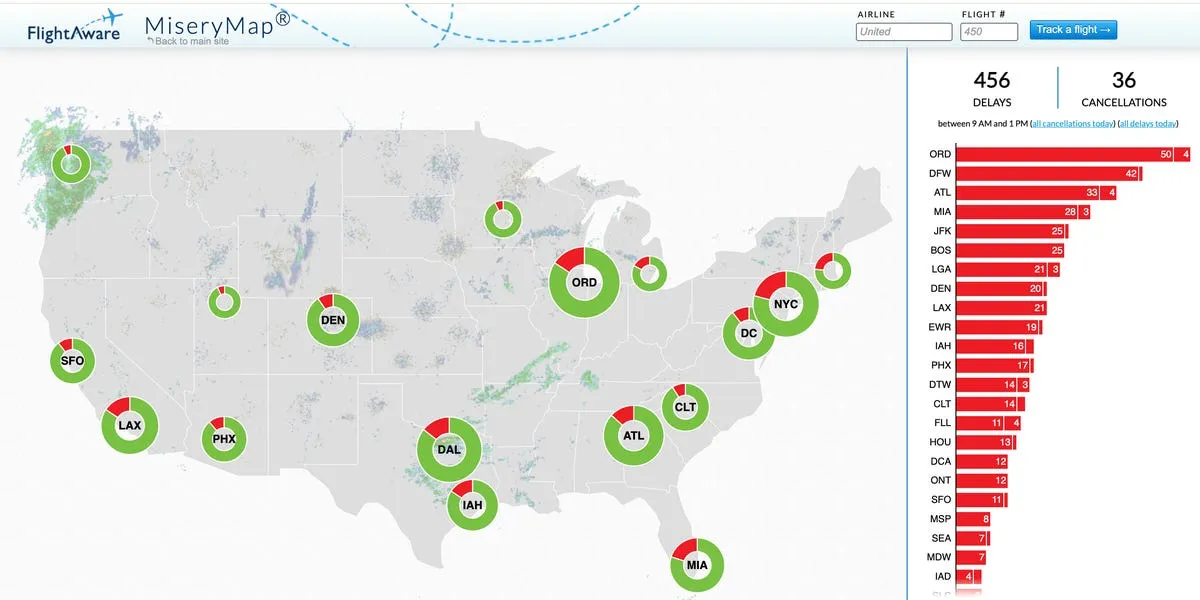
The ongoing government shutdown is significantly impacting air travel in the United States, leading to a surge in flight delays and cancellations. An online tool known as the Misery Map provides a comprehensive overview of which major U.S. airports are currently experiencing the most severe disruptions. This situation arises from a critical shortage of air traffic controllers, who are working under challenging conditions without pay.
On Friday, major airports such as LaGuardia Airport, John F. Kennedy International Airport, and Newark Liberty International Airport faced cascading disruptions. Many air traffic controllers called out sick as they continue to work without compensation. The Flight Aware website, known for its real-time and historical flight tracking data, has been tracking these issues using its Misery Map, which has documented delays and cancellations at 17 major U.S. airports since October 30.
Since Friday, more than 9,000 flight delays have been reported across the nation, including over 650 cancellations. Specifically, on Saturday before 4 p.m. ET, there were around 2,800 delays and nearly 160 cancellations. Airports in major metropolitan hubs, such as Dallas-Fort Worth International Airport, Los Angeles International Airport, and Denver International Airport, topped the misery index with 153, 83, and 86 delays, respectively.
Data from aviation analytics company Cirium indicates that airports in the metro New York area, including LaGuardia, JFK, and Newark, have experienced the highest ratio of canceled flights to scheduled flights on Thursday and Friday mornings. While disruptions showed some improvement on Saturday, analysts noted that the overall number of flights tends to be lower on weekends.
As of 4 p.m. ET on Saturday, the Federal Aviation Administration (FAA) had issued 14 staffing advisories affecting air traffic control towers and other facilities. Flights that are still operational may experience longer durations due to necessary reroutes around understaffed centers. This pattern of delays and disruptions has persisted since the government shutdown began on October 1, primarily due to a lack of certified air traffic controllers.
All air traffic controllers are currently working without pay, having received partial wages during the initial weeks of the shutdown. However, as of October 28, their paychecks ceased, leaving many controllers in a difficult financial situation. In response, airline pilots and flight attendants have been providing essential support, including sending free meals to controllers stationed at various airports nationwide.
On Friday evening, the FAA issued a statement via X, highlighting the ongoing shortage of air traffic controllers. Nearly 13,000 controllers are currently ensuring the safety of over 50,000 daily operations across the national airspace system (NAS). The FAA is urging the administration to conclude the shutdown, emphasizing that "the shutdown must end so that these controllers receive the pay they've earned and travelers can avoid further disruptions and delays."
The National Air Traffic Controllers Association (NATCA), a labor union representing air traffic controllers, has expressed its discontent with the ongoing situation. NATCA has stated that it does not support any coordinated activities that negatively impact the capacity of the NAS. In a recent message to its approximately 20,000 members, the union emphasized the importance of maintaining a high level of public service during this critical time.
Earlier this week, NATCA President Nick Daniels publicly urged lawmakers to pass a short-term spending bill to put an end to the shutdown. "Whatever the means are, whatever the way that they get it done, that's what the American people deserve, that's what the flying public deserves, and especially our air traffic controllers," Daniels stated at a press conference at Ronald Reagan Washington National Airport. As the situation evolves, both travelers and aviation professionals are hoping for a swift resolution to restore normalcy to U.S. air travel.